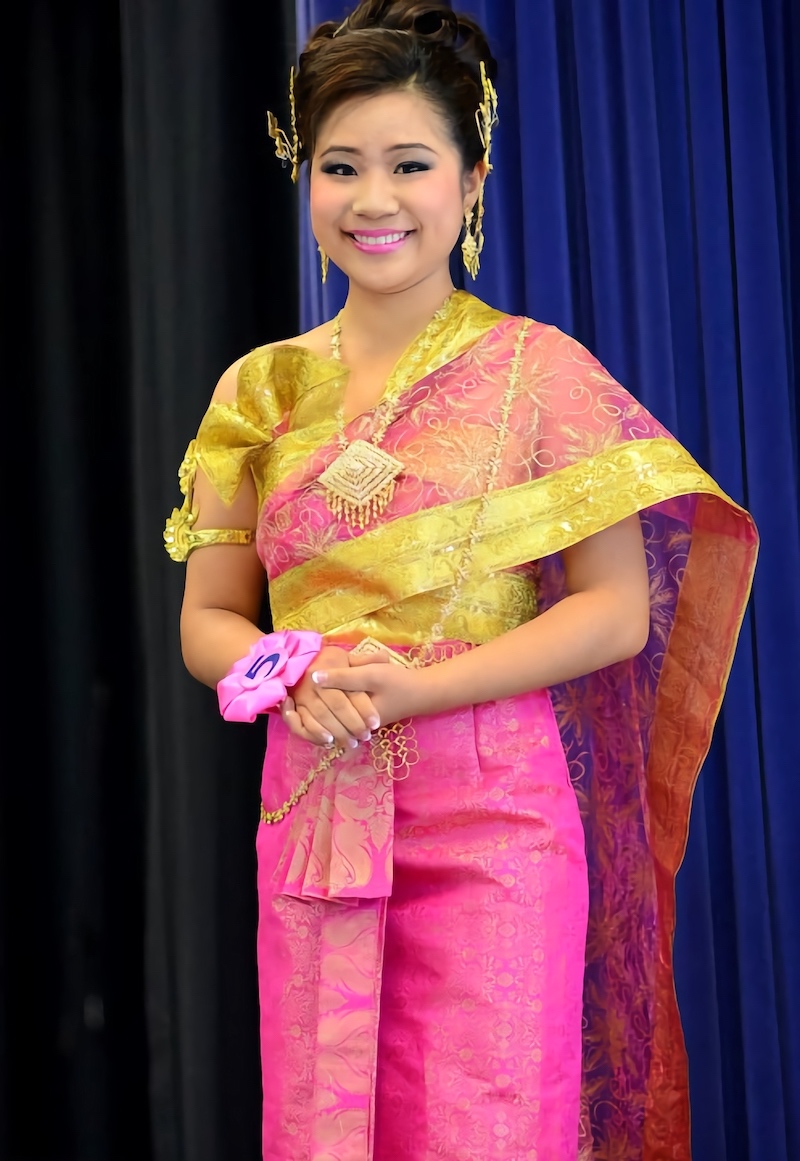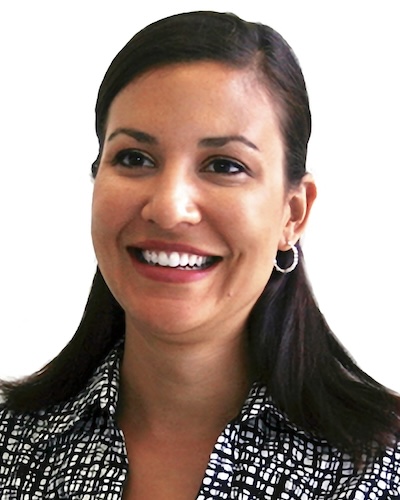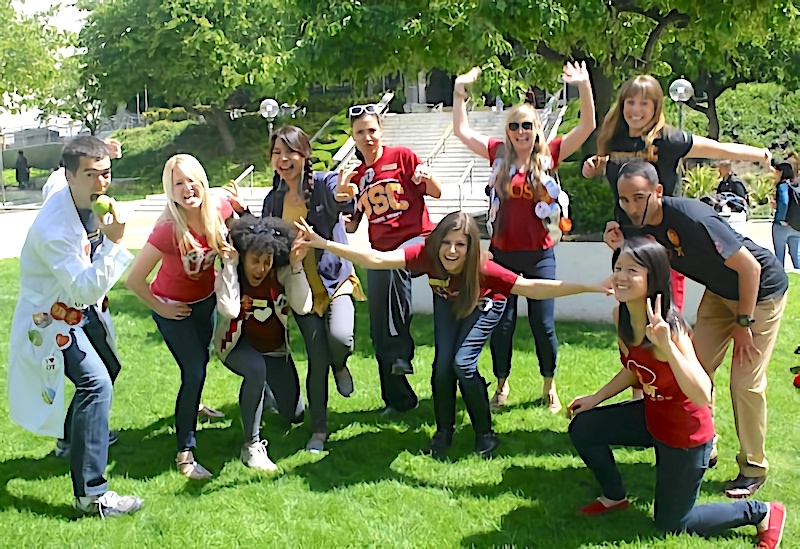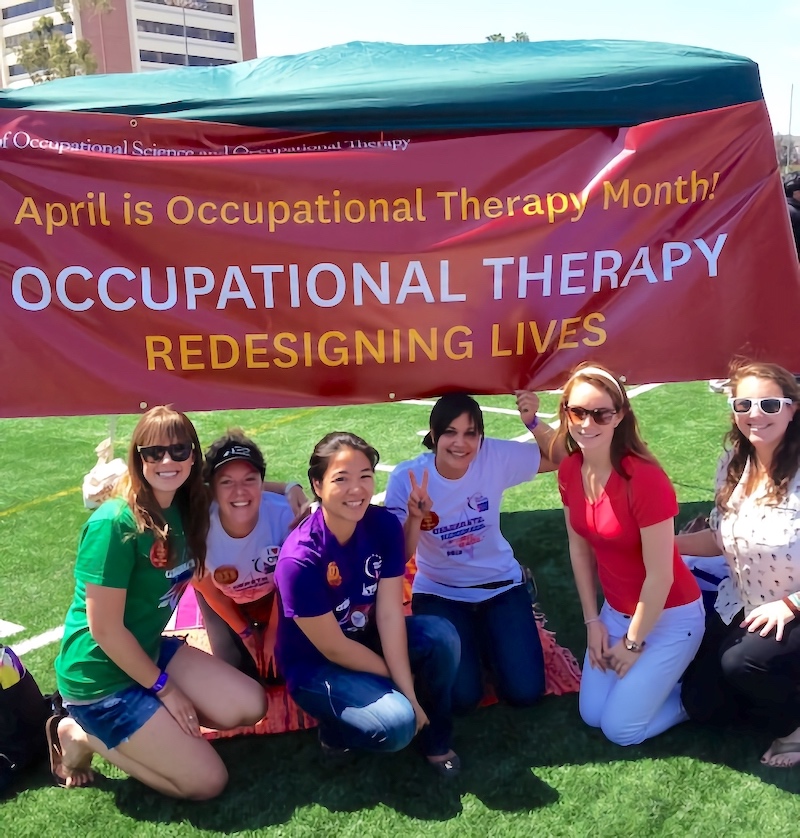Student Blog
Classes

Conference and pageant ⟩
May 1, 2013, by Alisa
Classes Community Getting Involved School/Life Balance
Yes, I made it to my last class as a Master’s student! In Lifestyle Redesign class today, I facilitated my healthy eating group on the topic of superfoods. I hope to work in health and wellness in the future, perhaps owning my own business and implementing Lifestyle Redesign concepts into my practice. I learned a lot from the group members and added to my OT toolbox. I few more hurdles to jump before I graduate. I can’t believe it.
I’ve never felt more tired and sleep deprived until this week. Grad school isn’t easy, but it’s manageable. This past weekend I attended the American Occupational Therapy Association Conference in San Diego. This was my second conference I attended. One perk about attending USC OT Program is that the division sponsors a number of students to attend these conferences, and I was fortunate enough to be one of the students chosen to attend! I realize how small and big the OT community is. I ran into my past supervisor and met my future supervisors there. I also ran into a student from Samuel Merritt University who presented a poster on oncology there as well. I remember hanging out with her last year at the conference in Indianapolis. I also saw a student from CAL State Domiguez Hills who did fieldwork at the same place as me last summer. That’s not it. I also ran into a prospective OT student whom I had given a tour to earlier in the semester. The conference is open to everyone!
I also met new people as well . . . in the jacuzzi. I met three wonderful USC PhD graduates, who now hold faculty positions at universities across the US. One of them in particular, Dr. Pollie Price from Utah, co-authored one of my favorite articles that I’ve read! I remember reading the article Mother Becoming: Learning to Read Mikala’s Signs by Pollie Price and Stephanie Miner in my clinical reasoning class last year and how I really enjoyed it. A lot of the articles and books that we read in class also come from our very own USC faculty, so I feel that I’m very fortunate to have picked the best school to go to.
I was sad that I had to miss the Alumni Reception at the Conference because I had to come back early and prepare for Miss Thai New Year Pageant. I volunteered to help out the temple by participating in the pageant. This was my second pageant (the first one I had done last year just for the heck of it). I ended up helping the temple raise close to $1,000 by selling balloons at the event. The total amount raised by all of the participants were close to $2,000. It was amazing to know that there was so much support and joy at the event. There was also a talent show portion that I was very surprised to have gotten second place for singing Tian Mi Mi, a classic Chinese song. The last portion of the pageant was to dress in a Thai traditional dress and pose. How hard could that be right? It was actually a pain to figure out how to best wear the traditional dress, but without the support from family, friends and strangers, I wouldn’t have survived the event. I ended up getting dehydration and a headache that lasted two days afterwards, but to know that I’ve helped a great cause in raising money for the temple, I am grateful.

⋯

Feelin Competent ⟩
April 18, 2013, by Ricky
Classes What are OS/OT?
Last night was our practicum in motor control class. A practicum, in this case, is an exam that tests your application of techniques learned in class (and practiced in lab). The techniques we were tested on were primarily mobilizations. You would typically be using mobilizations with someone who has experienced neurological trauma which has impacted their ability to control certain muscles. Mobilizations help align and stretch affected areas and provide feedback to the nervous system. To do a mobilization, you place your hands on respective landmarks throughout the skeletal system and apply force in varying directions. Apparently, our instructor has a great deal of faith in us because he had us do the mobilizations BLINDFOLDED! The anticipation of doing an exam blindfolded was pretty nerve-wracking. However, once we got started, it was as if my body was on auto-pilot. I was surprised by how natural it felt. This was such a confidence-booster. At the end, the clinical instructor provided us with feedback. He had no comments for me! I was pretty ecstatic.
⋯

Wow Wow Wow ⟩
April 11, 2013, by Amber
Classes Getting Involved School/Life Balance
Life has been moving at a million miles per hour since my last post! It seems that EVERYTHING happens in the Spring, and my life has been incredibly full of a variety of tasks and fun activities. I have been learning more about my path through the doctoral program and getting prepared for that transition. Another transition has occurred with the onboarding of the new student ambassadors who will be entertaining you with their blogs starting in a few short weeks! The new ambassadors have already been involved in several events. On April 1st, we celebrated the start of OT Month by hosting a rally with lunch, skits, and some awesome OT swag! Just last week, we hosted the incoming students at the Admitted Students’ Reception at the beautiful Town and Gown venue at USC.
The AOTA national conference for occupational therapists will take place in a couple of weeks. I am so proud to be presenting my research on animal assisted therapy at the conference as a poster presentation! I am also looking forward to Dr. Florence Clark’s farewell address and the special USC Alumni celebration taking place on Saturday night. I was also honored to be a part of our Division campaign video, which will be unveiled at the celebration.
Attending the Occupational Therapy Extravaganza last Saturday was a wonderful experience. It is planned each year by our honor society PTE, and they hosted a day of amazing speakers and creative showcases of our students’ work. In my role as Co-Chair of our student council OTSC, I have also been spending several hours per week planning our students’ end of the year celebration, for which we have chartered a private boat for a night cruise with a DJ, photo booth, and more fun! I am greatly looking forward to that celebration, and the even more amazing celebration a week after when I graduate from this program with a Master’s degree.
With all this excitement it is easy to forget that I still have lots of coursework and projects to complete, not least of all our comprehensive exam which covers material we have learned across the entire program! I can’t believe it will all be over in a few short weeks!

The present and future Student Ambassadors
⋯

Better late than never ⟩
April 10, 2013, by Paula
Classes Community Externships Getting Involved
It has been WAY too long since I have made an entry (whoops!). The past month has been filled with so many activities, visitors, projects, discussions, and so much planning for the remainder of the semester! Although the externship is now a few weeks behind us, I know that it is constantly present in each of our minds. As I mentioned weeks ago, I had the amazing opportunity to work alongside an interdisciplinary palliative care team here in Los Angeles and to advocate the importance of an OT being a member of their team. My experience was so eye-opening and I think of the people I worked with through those two weeks still every day — I know that this will not change anytime soon. The team was extremely receptive and supportive of what I had to bring to the table and of my ideas and examples for the applicability of OT to serve this population. It was a very exciting, invigorating experience for me to be able to advocate for the profession in this way.
Needless to say, this is a challenging population to work with no matter how you look at things. Overall, it was great to see how the team supports one another and how they ultimately put the family and their concerns at the forefront of treatment. Although we would all wish this quality of treatment for a family member or friend, it is sadly not the reality for many people needing medical attention. One of the most powerful experiences I had during my externship occurred in debrief/conversation with my direct supervisor after we had visited a patient and the family. She told me: “you have to have somewhere to put all of this.” And it is as simple as that. We require balance just as our patients do. If we as practitioners don’t take the time to process and really work through what we are experiencing in the workplace, then how are we possibly expecting to provide our patients with the highest quality of care we can offer? It made me think back to a professor within the Division who told the class in one of our first lectures when we began the program. She told us all that “you need to have therapy before you can give therapy.” This gives a whole new way for us as OTs to evaluate our own capacity for MINDFULNESS. :]
This past Friday, the Division hosted the Admitted Student Reception in which we welcomed the newest addition to the USC OT family — SO FUN! It was great to be a part of this event as a Student Ambassador, as I very clearly remember the 2011 Reception where I finally decided to take the USC plunge :] The new class is amazing and so enthusiastic about OT.
Saturday was the annual Relay For Life at USC. This event is a 24-hour fundraiser for The American Cancer Society and has been close to my heart for many years. Our team this year, “OT4LIFE,” was a great representation of OT spirit. This event made me think back to the days at my externship site and the support and value that a community can provide to someone fighting through such a hard battle, such as those living with cancer. Many of the children I worked with had been told that they would not make it to their next birthday. At Relay, I was able to speak with several adults who had been told the same thing, either about their own health or that of their child. But they were still present at an event in order to give back and continue to be involved in the community which had offered them support in a difficult time. Talk about perseverance and having the will to FIGHT BACK. Read about one of the touching stories shared at Relay For Life.

We’re just 10 days into April and OT month with so many awesome events and experiences already. Keep them coming, I’m loving it.
⋯

Inspired ⟩
February 12, 2013, by Paula
Classes What are OS/OT?
So this entry may seem to mirror Amber’s last post a bit but I have been feeling the same excitement at the progress I know that we all have made over the past years. I feel like we are finally pushing away those clouds of self-doubt that come with being a novice, wide-eyed student and are looking forward to exploring what our future careers will be with anticipation. The energy is definitely different mid-way through this final semester and it’s as though there was a transformation sometime within the winter break which really ignited the class. This is a great thing!!
Within the Motor Control elective, I have had the opportunity to meet some amazing people. My clinical observation placement is located in the Jacquelin Perry Institute (JPI) at Rancho Los Amigos National Rehabilitation Center, where I primarily follow an OTR/L who works with patients in the Stroke Rehabilitation program. I know that you have heard each of us mention Rancho by now. This rehabilitation center is certainly deserving of the highly esteemed reputation it has developed over nearly a century of providing services. The aspect of Rancho which I value most as a student is the enthusiasm for learning and the obvious effort that each member of the rehabilitation team makes to encourage students while also maintaining such a high quality of care for the people they treat each day. For every student who has started out in the clinical setting, there are those moments of, “Oh no, I cannot remember what they said about this in class,” interspersed with moments of “But, what if I do something wrong?!” It is normal; it is called ‘learning’; and it happens to us all along the way. When a location makes an obvious effort to support the learning experience and clearly has confidence in the ability of the student, as they do at Rancho, it resonates with the students.
Today during lab, a fellow student and I were told that we would be leading a co-treat with a gentleman we have observed in therapy before. We were able to evaluate, compete an occupational profile for the individual (including his prior function, changes he has experienced and what he would like to get back to doing), assess his scapular and thoracic alignment and perform scapular mobilizations to facilitate a more appropriate posture necessary to support activity in therapy. It has been so gratifying to work with people through the many different settings in fieldwork and to learn so much from each of them along the way . . . I feel like I am always saying this, but I am so looking forward to actually being an OT (soon)!
⋯





